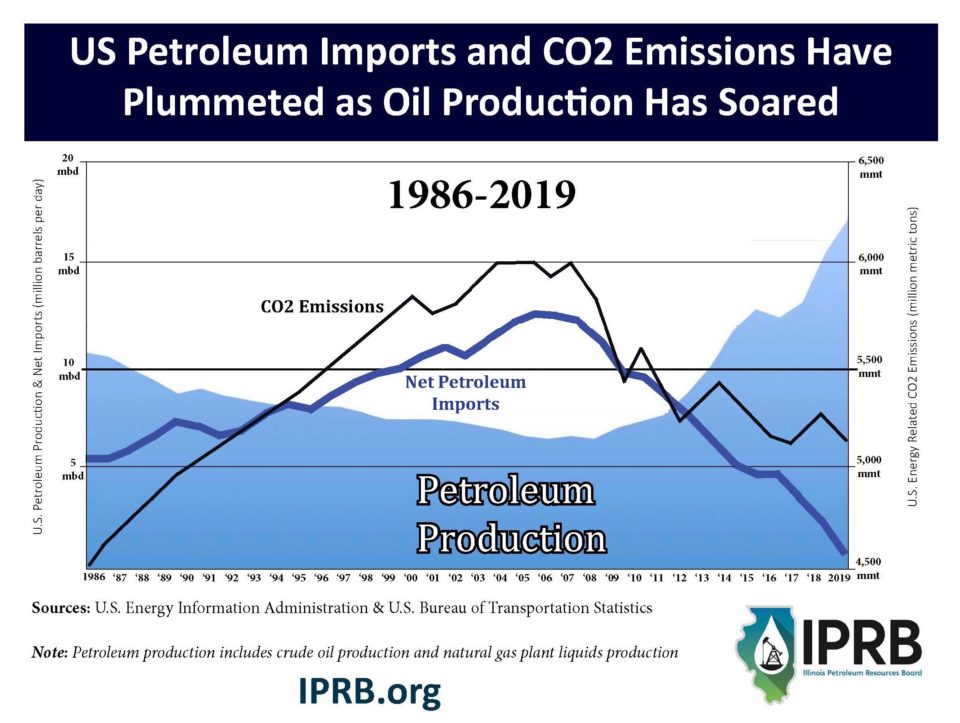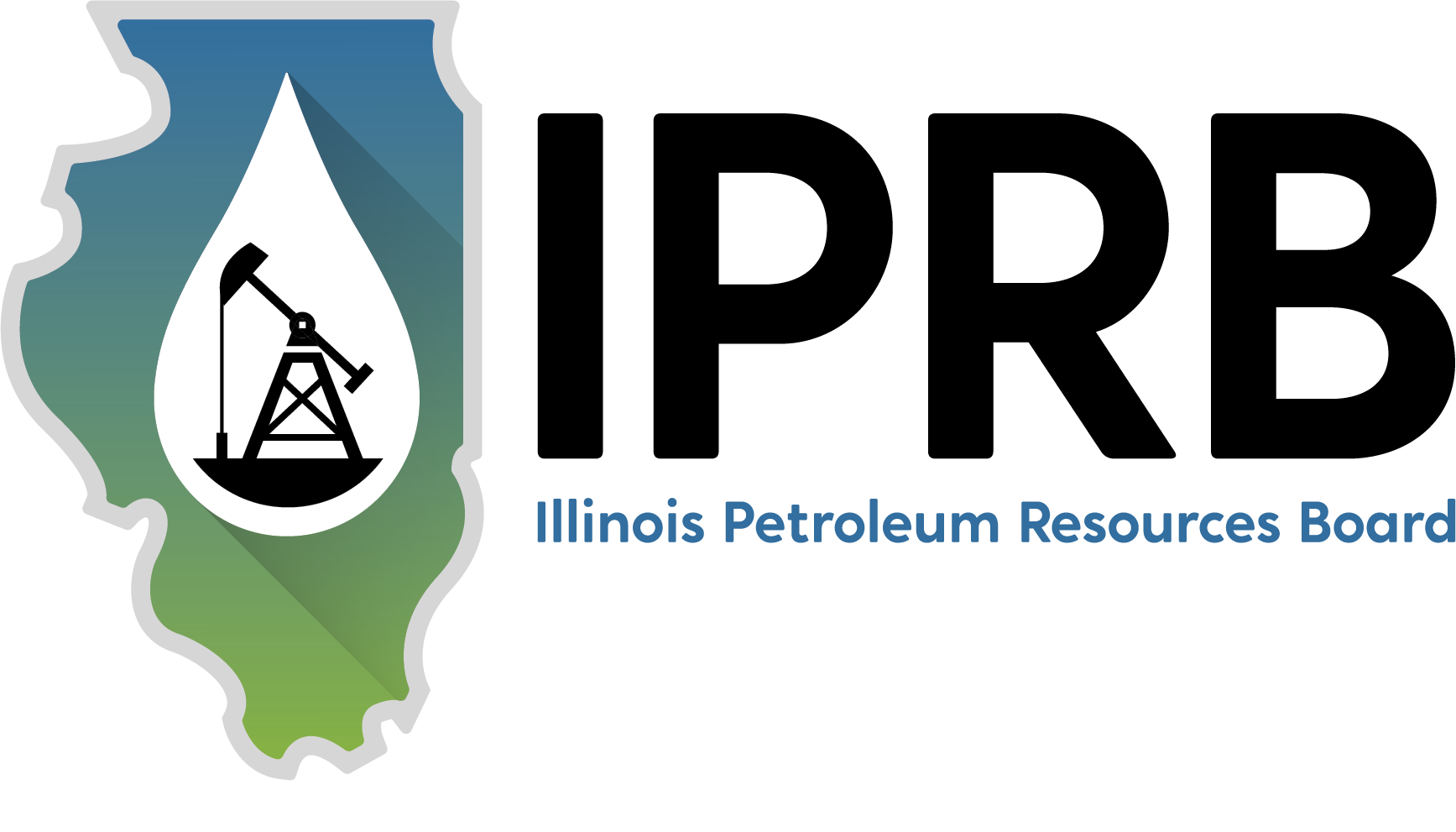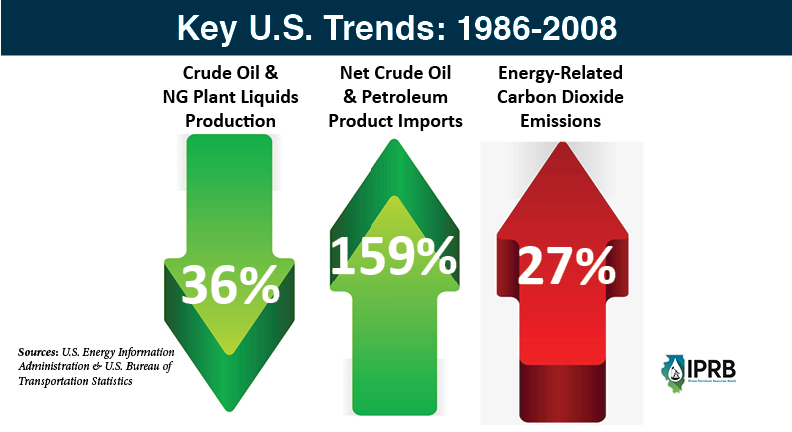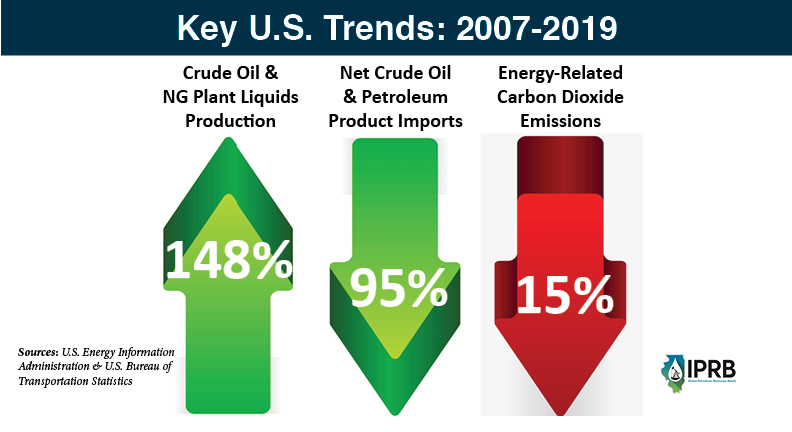Policies Aimed at Reducing U.S. Oil Production Will Only Increase Imports
Policies designed to deliberately decrease U.S. oil production have gained mainstream traction in recent years. The justification for such policies is the theory that curtailing domestic production will also drive down U.S. oil consumption and, subsequently, lower greenhouse gas emissions.
But a review of recent historical energy data shows that this widely held “Keep It In the Ground” belief has little basis in reality.
As the following IPRB chart shows, recent periods of decreased domestic petroleum production have coincided directly with sharp spikes in petroleum imports and CO2 emissions, while the recent spike in domestic petroleum production has coincided with plummeting imports and CO2 emissions.
 This data show that “Keep It In the Ground” policies would only increase petroleum imports, strengthening our foreign competitors geopolitical standing while weakening our energy security and economy – all while possibly lead to a rise in emissions to boot.
This data show that “Keep It In the Ground” policies would only increase petroleum imports, strengthening our foreign competitors geopolitical standing while weakening our energy security and economy – all while possibly lead to a rise in emissions to boot.
Case Study: 1986-2008 – Declining Production, Soaring Imports & Emissions
The longest period of sustained oil production decline in U.S. history – 1986 to 2008 – provides a perfect example of the fact that declining production does not lead to a reduction in domestic oil demand – it only leads into increased imports from oftentimes hostile foreign sources in order to meet demand. Oil consumption, petroleum imports and carbon dioxide emissions (CO2) all soared to record levels during this 22-year time period despite a dramatic decline oil production in the U.S.
Data from the U.S. Energy Information Administration (EIA) show that from 1986 to 2008, U.S. oil production declined 44 percent and overall petroleum production – including crude oil and natural gas plant liquids production – was down 36 percent. Based on the logic used to justify policies aimed at deliberately decreasing U.S. production, one might assume that U.S. oil consumption and carbon dioxide emissions declined as during this time as well. But the opposite was actually true.
CO2 emissions increased 27 percent during that time-span and despite free-falling domestic oil production, U.S. oil consumption increased 24 percent from 1986 to 2008. To meet oil demand, foreign imports of oil and petroleum products ballooned, and our net petroleum imports grew by a whopping 159 percent. In fact, the United States was the world’s largest oil importer in 2008.
As the following graphics show, U.S. energy and emissions trends during this period of time were troubling, to say the least.
Anybody who is old enough to legally have a beer probably remembers that the mid-to-late 2000s were a time of considerable angst on the domestic energy front. U.S. oil production dropped to just 5 million barrels per day in 2008 and “peak oil” fears became rampant. U.S. net petroleum imports peaked at 12.5 million barrels per day in 2005 and our carbon dioxide emissions reached all-time highs in 2007.
U.S. oil demand has continued to grow consistently since 2008. But fortunately, our domestic production and natural gas production has skyrocketed, allowing the United States to reverse the above trends and put us closer to our long-coveted goal of energy independence than anyone could have imagined just a decade ago.
But now, with oil demand artificially depressed by the COVID-19 pandemic, it is easy to forget that global oil consumption will likely rebound sharply once the pandemic is behind us. After all, global oil consumption reached an all-time high of nearly 100 million barrels per day in 2019, with the United States accounting for more than 20 percent of that consumption. The latter fact noted, the United States will no doubt return to the days of being the world’s leading oil importer if policies aimed at intentionally reducing domestic production are implemented.
That would be great news for major oil producing nations such as Saudi Arabia and Russia, who would no doubt regain the market share and geopolitical leverage they lost when the United States emerged as the world’s top oil producer this past decade.
And though it might seem counter-intuitive, a decrease in domestic oil and natural gas production would likely spike our CO2 emissions as well.
A dramatic increase in U.S. oil production over the past decade-plus has been coupled with a world-leading decline in CO2 emissions (nearly 800 million metric tons).
This can largely be explained by the fact that record U.S. production clean-burning natural gas – large quantities of which are co-produced with oil in places such as the Permian Basin in Texas and New Mexico – have allowed the United States to reduce emissions considerably.
Policies aimed at curtailing U.S. drilling will make natural gas more expensive and less plentiful and likely increase coal use, considering intermittent renewable energy is nowhere near reliable enough to power a developed society with a modern economy. Increased coal use would lead to a reversal in downward emission trends seen since about 2005.
Conclusion
It wasn’t that long ago that “peak oil” fears and the assumption that the United States would be under the thumb of the OPEC cartel for decades to come were prevalent. But thanks to the ingenuity of U.S. producers, we are now the world’s undisputed leader in oil and natural gas production, a net oil and natural gas exporter and have led the world in CO2 emission reductions this century.
Fortunately, many Americans recognize these facts and see the folly in policies that would reverse these trends. Recent polls show strong support domestic oil and natural gas production throughout the United States, including Illinois:
- A recent survey of 700 Illinois residents commissioned by the Grow America’s Infrastructure Now (GAIN) coalition finds 90 percent of respondents believe it’s important for the United States to be energy independent, while 85 percent agree that the oil and gas industry is important to the Illinois economy.
- A recent Morning Consult poll of respondents in 12 energy-rich states found that 64 percent of respondents are likely to vote for a candidate who “supports policies that ensure consumers continue to have access to natural gas and oil produced in the U.S.”
- A recent survey of 3,631 voters and likely voters across Iowa, Michigan, Minnesota, Ohio, Pennsylvania and Wisconsin conducted by the The Epoch Times found that 42 percent support “fracking [hydraulic fracturing] as a means of increasing oil and natural gas production in the U.S,” compared to 32 percent that oppose it.
As energy expert Daniel Yergin recently noted, “The world still runs on oil and oil will be a very major part of the energy mix for quite a long time… If you ban fracking [hydraulic fracturing] it’s an import-more-oil-policy.” Hopefully, policymakers will take note.





